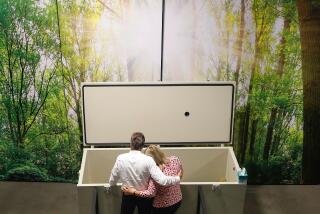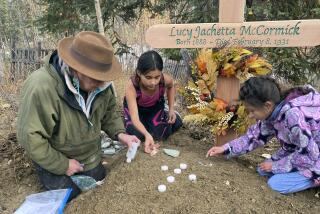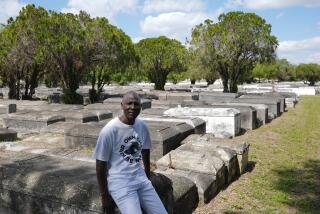Burials Are a Rite of Spring in Alaska
FAIRBANKS, Alaska — As spring thaws the ground made hard as granite by a long Alaska winter, cemeteries throughout the state are preparing to bury scores of people who died during the last seven months.
Since October, when digging through the earth became next to impossible, many of Alaska’s dead have been stored in coolers and containers. Now, families will finally be able to inter their loved ones in a somber Far North rite of spring.
“It’s around Memorial Day when we go down 6 feet,” said David Erickson, cemetery manager of Northern Lights Mortuary and Memorial Park in Fairbanks. “We’ll start earlier for infants and urns.”
Funeral homes and cemeteries have begun contacting families to schedule graveside services through June.
Dave Jacoby, public works director for Fairbanks, which operates Birch Hill cemetery, said burials there began last week. Scheduling is flexible for families coming from outside Alaska.
This year, there will be 22 burials at Birch Hill. City workers will double as pallbearers for some services that take place over the next several weeks.
Northern Lights, which stored about 15 bodies this winter, begins its burials in the latter part of May because it’s at a higher elevation and gets less exposure to the sun.
In Fairbanks, in interior Alaska, winter temperatures can dip to 40 below zero or lower. Even in places with milder climates, such as Anchorage, the ground still freezes, and many cemeteries close in the fall.
The amount of time it takes to dig through the frozen ground, and the possibility of defiling other graves with heavy equipment, led to the practice of storing bodies decades ago.
“The ground is so hard, we’d be digging a grave for three days,” Jacoby said.
Delayed burials occur in other frigid climes across the north, including New England and northern Minnesota. But in Canada, winter burials are the norm, said Roger Yador, director of Heritage North Funeral Home in the Yukon Territory city of Whitehorse.
The storage crypts where the bodies are held for the winter in Alaska vary. At Northern Lights, it is a simple metal container hidden from view of the grave markers, alongside the backhoes and crypt liners.
Birch Hill’s cold storage resembles a mausoleum. The brick building has three rows of brass doors on either side and can hold more than 50 coffins. An opening in the roof draws the cold air inside and helps preserve the bodies.
Angelus Memorial Park has the only storage cooler in Anchorage. It’s indoors and refrigerated, with the temperature kept between 34 and 38 degrees. It can hold as many as 100 bodies. Six funeral homes store bodies in the cooler at a cost of $3 per day for bodies not being buried at the cemetery.
There is no state or federal oversight of thee storage facilities, and no inspections are made.
Erickson said the lack of oversight does not pose a problem. The families make sure that nothing wrong happens, he said.
“It’s something you have to self-regulate to stay out of court,” he said.
Angelus Memorial Park’s executive director, William Hamilton, said his cooler had been inspected by the Occupational Safety and Health Administration and an engineer at the cemetery’s request. There has never been a switched or misplaced body, he said.
Winter storage wasn’t always the practice. Before the cold storage units were built, winter burials were common. They’re still common outside the bigger cities. Alaska Natives choose not to wait to bury their dead.
“Why wait? We live in the cold and snow and ice. It seems barbaric to store them above ground and wait until springtime,” said Shirley Demientieff, an Athabascan who buried her grandmother Mary in the village of Nenana in January.
At her grandmother’s burial, relatives first cleared snow from the site, Demientieff said. Fire then slowly thawed the ground. As the ground became soft enough to dig, the fire was moved aside and the grave hand-dug with shovels and pick axes. When the diggers again hit frozen earth, the fire was moved back into the hole.
The Rev. Scott Fisher, a priest for the 1,200 members of St. Matthew’s Episcopal Church in Fairbanks, said he disagreed with the practice of storing bodies over the winter. The flow of a service from church to graveside is important psychologically for grieving families, he said.
“The sound of the earth on the casket -- ka-thud -- breaks through some of the shock and the grief,” he said.
“Say somebody dies and nothing happens for seven months. By that amount of time -- five months, six months, seven months -- a thin veneer of feeling has begun and it gets ripped off,” he said.
Fisher will hold services at two spring burials this year. Twenty-four members of his congregation died over the winter, but the majority were Native Alaskans and are already buried in villages outside of Fairbanks.
He said he held a special service at graveside because of the time that had passed.
“You’ve got to go back into the moment. We have to pull ourselves where we were when the funeral service ended,” Fisher said.
Jacoby said some families chose not to have graveside services in the spring, but asked the cemetery to notify them when a loved one is buried.
“I’ve seen people worse at the interment than at the actual service, because they relive it twice,” he said.
Erickson said Northern Lights had tried different ways to bury during the winter. Once the cemetery thawed a gravesite by using steam, but it was a costly process and more than most families could afford.
Another time, cemetery workers tried digging graves in advance, before the ground froze. That didn’t work either.
“It turned out nobody wanted those graves. They wanted to be by their relatives or in another spot,” Erickson said.
More to Read
Sign up for Essential California
The most important California stories and recommendations in your inbox every morning.
You may occasionally receive promotional content from the Los Angeles Times.










